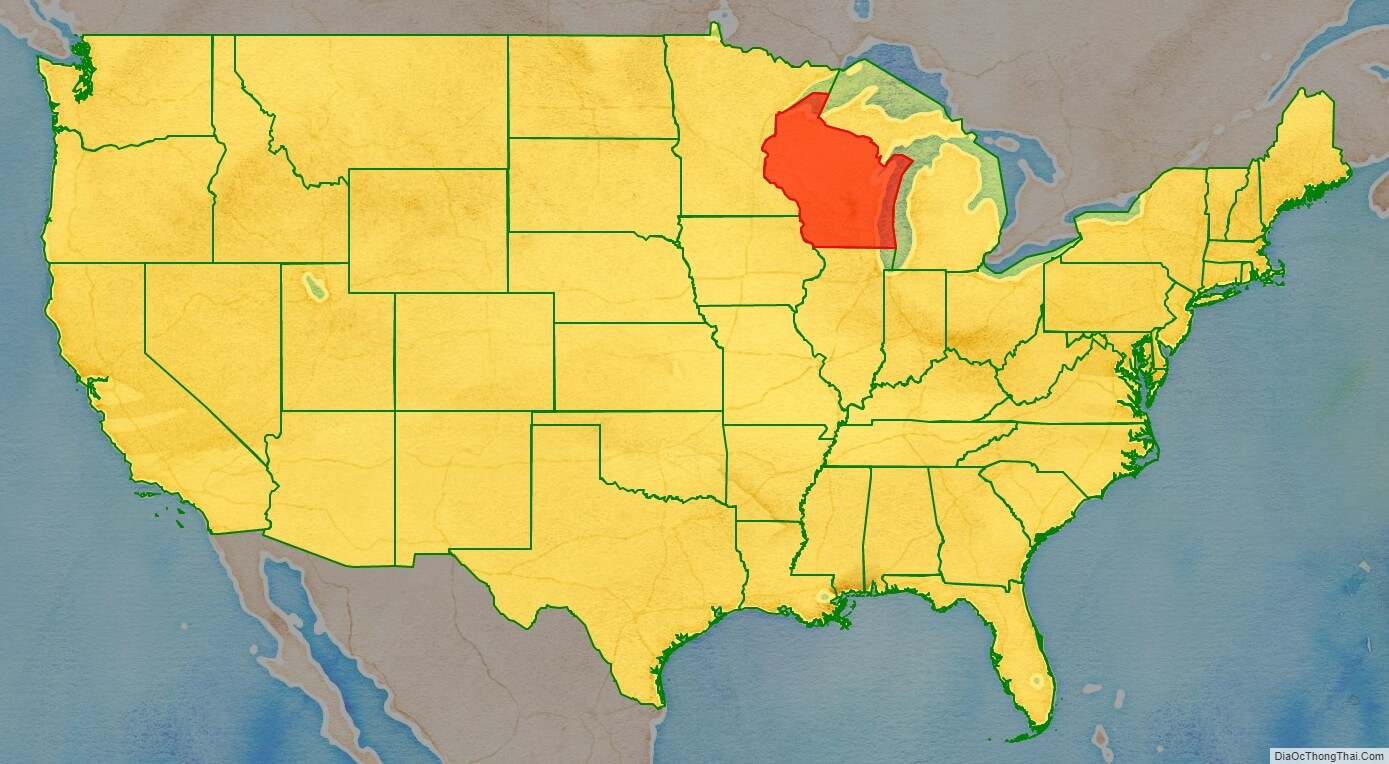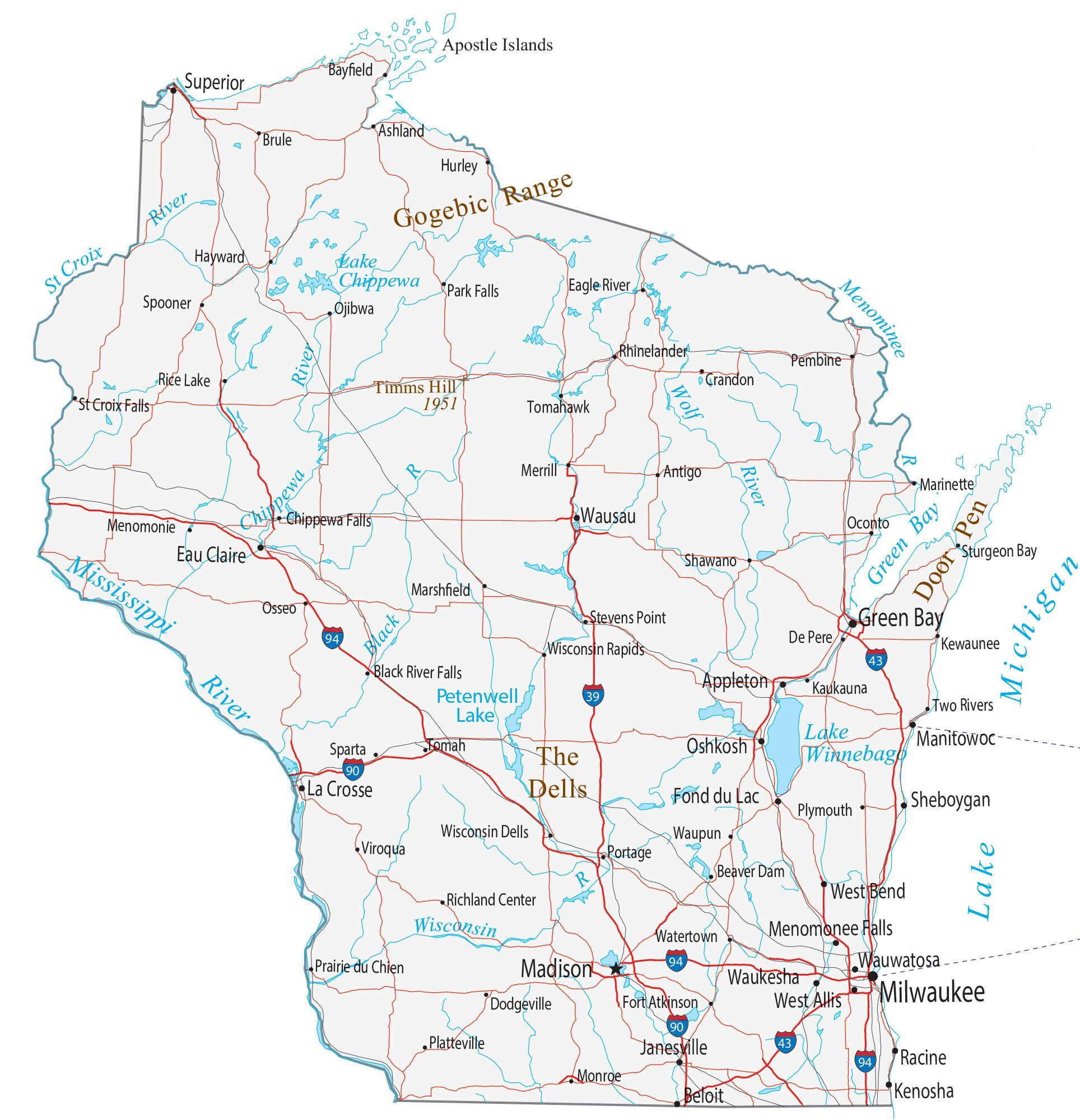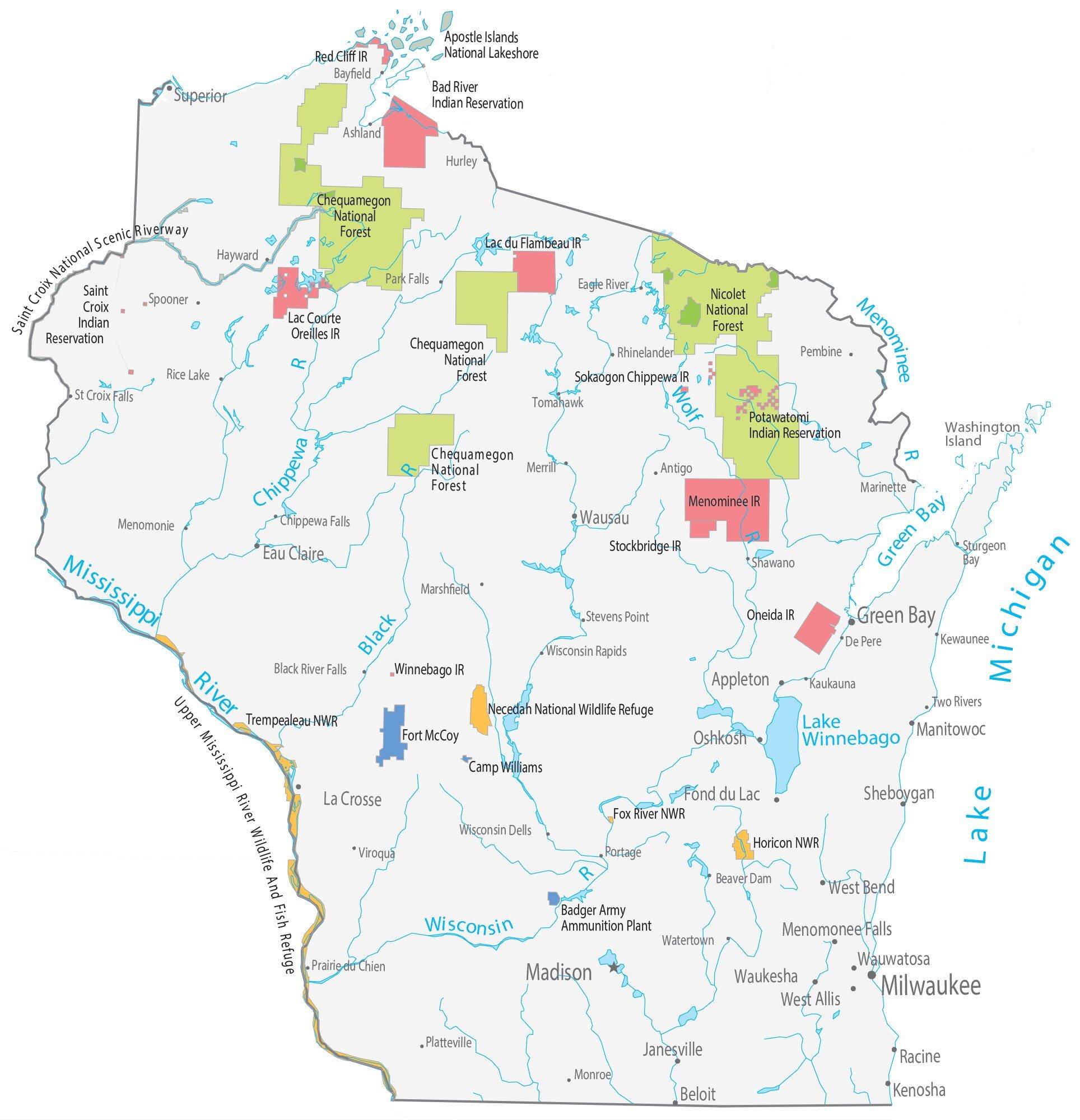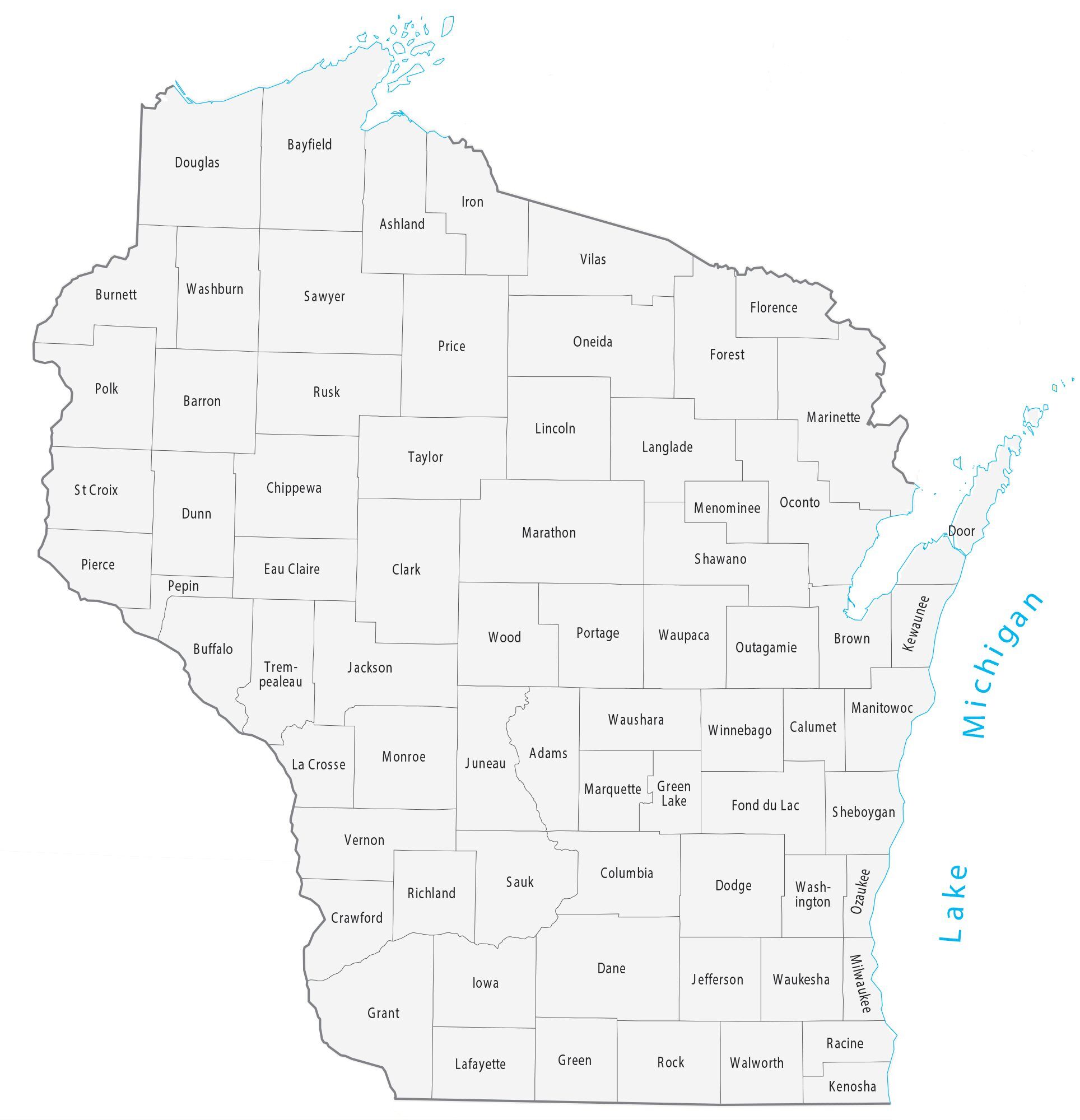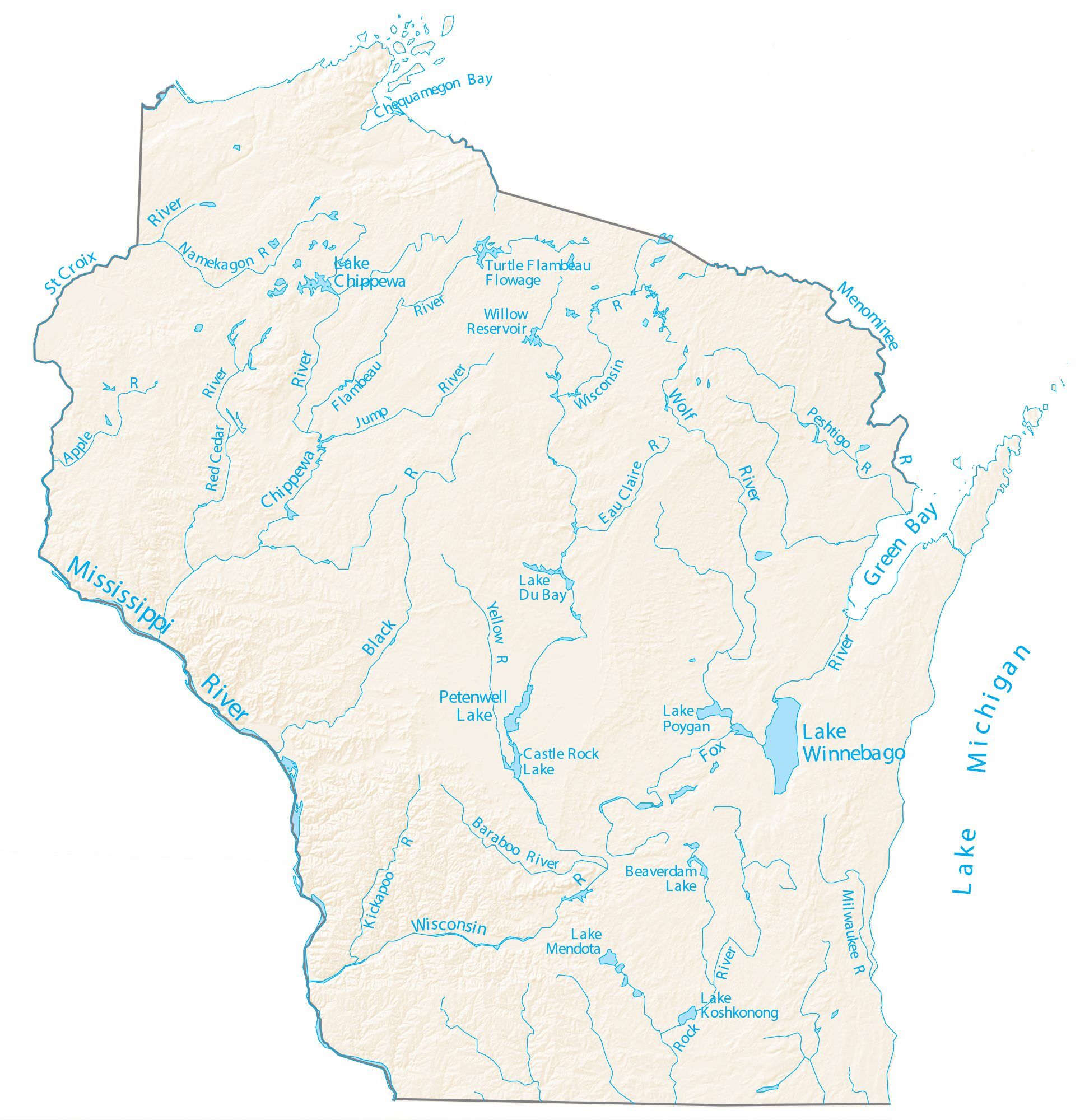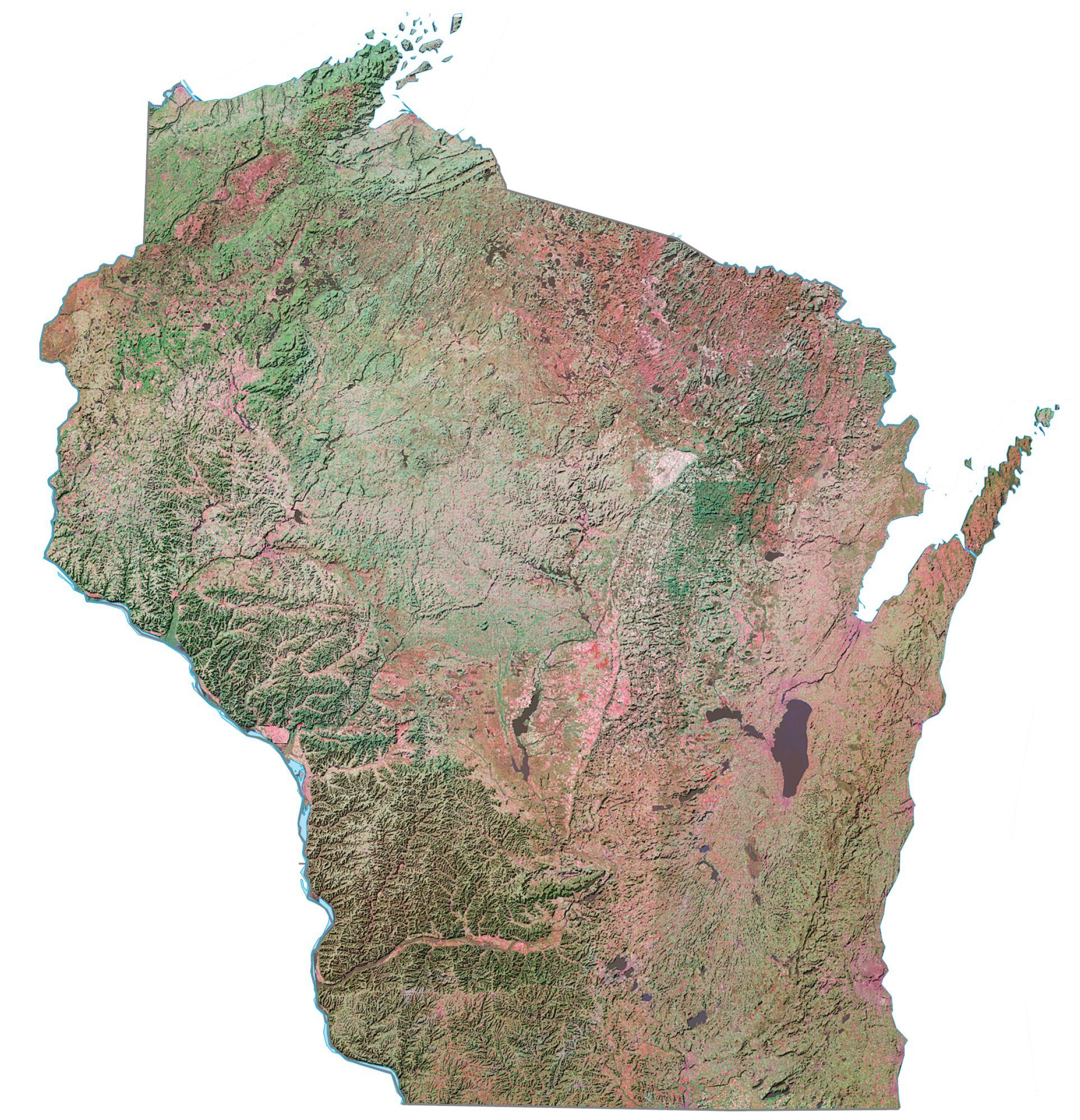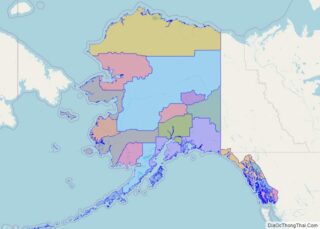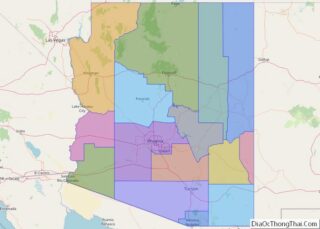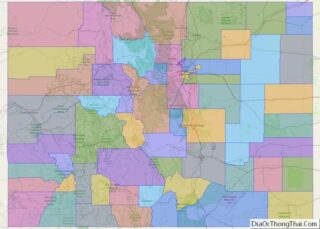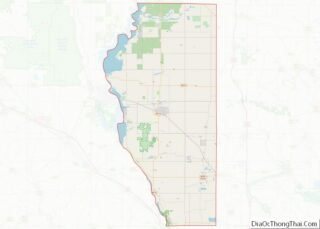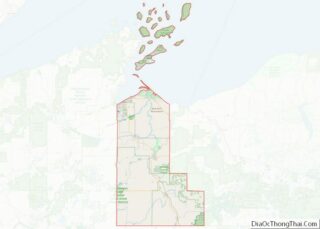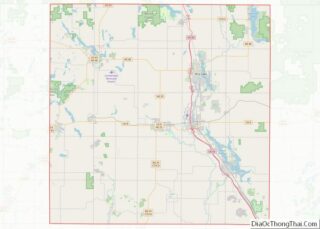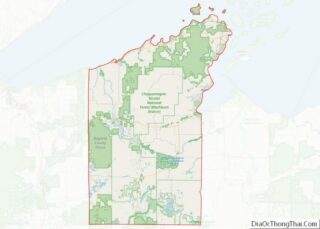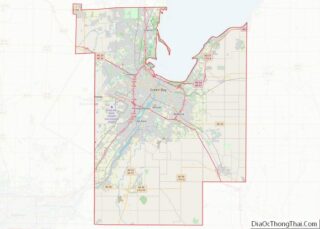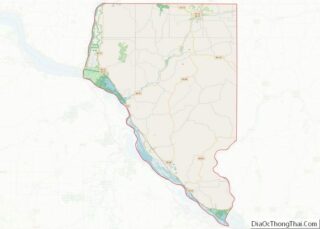Wisconsin (/wɪˈskɒnsɪn/ (listen)) is a state in the upper Midwestern United States. Wisconsin is the 25th-largest state by total area and the 20th-most populous. It is bordered by Minnesota to the west, Iowa to the southwest, Illinois to the south, Lake Michigan to the east, Michigan to the northeast, and Lake Superior to the north.
The bulk of Wisconsin’s population live in areas situated along the shores of Lake Michigan. The largest city, Milwaukee, anchors its largest metropolitan area, followed by Green Bay and Kenosha, the third- and fourth-most-populated Wisconsin cities respectively. The state capital, Madison, is currently the second-most-populated and fastest-growing city in the state. Wisconsin is divided into 72 counties and as of the 2020 census had a population of nearly 5.9 million.
Wisconsin’s geography is diverse, having been greatly impacted by glaciers during the Ice Age with the exception of the Driftless Area. The Northern Highland and Western Upland along with a part of the Central Plain occupy the western part of the state, with lowlands stretching to the shore of Lake Michigan. Wisconsin is third to Ontario and Michigan in the length of its Great Lakes coastline. The northern portion of the state is home to the Chequamegon-Nicolet National Forest.
At the time of European contact the area was inhabited by Algonquian and Siouan nations, and today is home to eleven federally recognized tribes. During the 19th and early 20th centuries, many European settlers entered the state, most of whom emigrated from Germany and Scandinavia. Wisconsin remains a center of German American and Scandinavian American culture, particularly in respect to its cuisine, with foods such as bratwurst and kringle. Wisconsin is home to one UNESCO World Heritage Site, comprising two of the most significant buildings designed by Wisconsin-born architect Frank Lloyd Wright: his studio at Taliesin near Spring Green and his Jacobs I House in Madison.
The state is one of the nation’s leading dairy producers and is known as “America’s Dairyland”; it is particularly famous for its cheese. The state is also famous for its beer, particularly and historically in Milwaukee, most notably as the headquarters of the Miller Brewing Company. Wisconsin has some of the most permissive alcohol laws in the country and is well known for its drinking culture. Its economy is dominated by manufacturing, healthcare, information technology, and agriculture—specifically dairy, cranberries and ginseng. Tourism is also a major contributor to the state’s economy. The gross domestic product in 2020 was $348 billion.
| Before statehood: | Wisconsin Territory |
|---|---|
| Admitted to the Union: | May 29, 1848 (30th) |
| Capital: | Madison |
| Largest city: | Milwaukee |
| Largest metro and urban areas: | Milwaukee |
| Elevation: | 1,050 ft (320 m) |
| Total Area: | 65,498.37 sq mi (169,640.0 km) |
| Area Rank: | 25th |
| Total Population: | 5,893,718 |
| Population Rank: | 20th |
| Population Density: | 108.8/sq mi (42.0/km) |
| Population Density Rank: | 27th |
| Median Household Income: | $64,168 |
| Income Rank: | 21st |
| Demonym(s): | Wisconsinite Cheesehead (colloquial) |
| USPS abbreviation: | WI |
| ISO 3166 code: | US-WI |
| Website: | www.wisconsin.gov |
Online Interactive Map
Click on ![]() to view map in "full screen" mode.
to view map in "full screen" mode.
Wisconsin location map. Where is Wisconsin state?
Wisconsin Road Map
Wisconsin Map – Roads & Cities
Wisconsin Street Map
History
Early history
Wisconsin has been home to a wide variety of cultures over the past 14,000 years. The first people arrived around 10,000 BCE during the Wisconsin Glaciation. These early inhabitants, called Paleo-Indians, hunted now-extinct ice age animals such as the Boaz mastodon, a prehistoric mastodon skeleton unearthed along with spear points in southwest Wisconsin. After the ice age ended around 8000 BCE, people in the subsequent Archaic period lived by hunting, fishing, and gathering food from wild plants. Agricultural societies emerged gradually over the Woodland period between 1000 BCE to 1000 CE. Toward the end of this period, Wisconsin was the heartland of the “Effigy Mound culture”, which built thousands of animal-shaped mounds across the landscape. Later, between 1000 and 1500 CE, the Mississippian and Oneota cultures built substantial settlements including the fortified village at Aztalan in southeast Wisconsin. The Oneota may be the ancestors of the modern Ioway and Ho-Chunk nations who shared the Wisconsin region with the Menominee at the time of European contact. Other Native American groups living in Wisconsin when Europeans first settled included the Ojibwa, Sauk, Fox, Kickapoo, and Pottawatomie, who migrated to Wisconsin from the east between 1500 and 1700.
European settlements
The first European to visit what became Wisconsin was probably the French explorer Jean Nicolet. He canoed west from Georgian Bay through the Great Lakes in 1634, and it is traditionally assumed that he came ashore near Green Bay at Red Banks. Pierre Radisson and Médard des Groseilliers visited Green Bay again in 1654–1666 and Chequamegon Bay in 1659–1660, where they traded for fur with local Native Americans. In 1673, Jacques Marquette and Louis Jolliet became the first to record a journey on the Fox-Wisconsin Waterway all the way to the Mississippi River near Prairie du Chien. Frenchmen like Nicholas Perrot continued to ply the fur trade across Wisconsin through the 17th and 18th centuries, but the French made no permanent settlements in Wisconsin before Great Britain won control of the region following the French and Indian War in 1763. Even so, French traders continued to work in the region after the war, and some, beginning with Charles de Langlade in 1764, settled in Wisconsin permanently, rather than returning to British-controlled Canada.
The British gradually took over Wisconsin during the French and Indian War, taking control of Green Bay in 1761 and gaining control of all of Wisconsin in 1763. Like the French, the British were interested in little but the fur trade. One notable event in the fur trading industry in Wisconsin occurred in 1791, when two free African Americans set up a fur trading post among the Menominee at present day Marinette. The first permanent settlers, mostly French Canadians, some Anglo-New Englanders and a few African American freedmen, arrived in Wisconsin while it was under British control. Charles de Langlade is generally recognized as the first settler, establishing a trading post at Green Bay in 1745, and moving there permanently in 1764. Settlement began at Prairie du Chien around 1781. The French residents at the trading post in what is now Green Bay, referred to the town as “La Baye”. However, British fur traders referred to it as “Green Bay”, because the water and the shore assumed green tints in early spring. The old French title was gradually dropped, and the British name of “Green Bay” eventually stuck. The region coming under British rule had virtually no adverse effect on the French residents as the British needed the cooperation of the French fur traders and the French fur traders needed the goodwill of the British. During the French occupation of the region licenses for fur trading had been issued scarcely and only to select groups of traders, whereas the British, in an effort to make as much money as possible from the region, issued licenses for fur trading freely, both to British and to French residents. The fur trade in what is now Wisconsin reached its height under British rule, and the first self-sustaining farms in the state were established as well. From 1763 to 1780, Green Bay was a prosperous community which produced its own foodstuff, built graceful cottages and held dances and festivities.
U.S. territory
Wisconsin became a territorial possession of the United States in 1783 after the American Revolutionary War. In 1787, it became part of the Northwest Territory. As territorial boundaries subsequently developed, it was then part of Indiana Territory from 1800 to 1809, Illinois Territory from 1809 to 1818, and Michigan Territory from 1818 to 1836. However, the British remained in control until after the War of 1812, the outcome of which finally established an American presence in the area. Under American control, the economy of the territory shifted from fur trading to lead mining. The prospect of easy mineral wealth drew immigrants from throughout the U.S. and Europe to the lead deposits located at Mineral Point, Dodgeville, and nearby areas. Some miners found shelter in the holes they had dug, and earned the nickname “badgers”, leading to Wisconsin’s identity as the “Badger State”. The sudden influx of white miners prompted tension with the local Native American population. The Winnebago War of 1827 and the Black Hawk War of 1832 culminated in the forced removal of Native Americans from most parts of the state.
Following these conflicts, Wisconsin Territory was created by an act of the United States Congress on April 20, 1836. By fall of that year, the best prairie groves of the counties surrounding what is now Milwaukee were occupied by farmers from the New England states.
Statehood
The Erie Canal facilitated the travel of both Yankee settlers and European immigrants to Wisconsin Territory. Yankees from New England and upstate New York seized a dominant position in law and politics, enacting policies that marginalized the region’s earlier Native American and French-Canadian residents. Yankees also speculated in real estate, platted towns such as Racine, Beloit, Burlington, and Janesville, and established schools, civic institutions, and Congregationalist churches. At the same time, many Germans, Irish, Norwegians, and other immigrants also settled in towns and farms across the territory, establishing Catholic and Lutheran institutions.
The growing population allowed Wisconsin to gain statehood on May 29, 1848, as the 30th state. Between 1840 and 1850, Wisconsin’s non-Indian population had swollen from 31,000 to 305,000. More than a third of residents (110,500) were foreign born, including 38,000 Germans, 28,000 British immigrants from England, Scotland, and Wales, and 21,000 Irish. Another third (103,000) were Yankees from New England and western New York state. Only about 63,000 residents in 1850 had been born in Wisconsin.
Nelson Dewey, the first governor of Wisconsin, was a Democrat. Dewey oversaw the transition from the territorial to the new state government. He encouraged the development of the state’s infrastructure, particularly the construction of new roads, railroads, canals, and harbors, as well as the improvement of the Fox and Wisconsin Rivers. During his administration, the State Board of Public Works was organized. Dewey, an abolitionist, was the first of many Wisconsin governors to advocate against the spread of slavery into new states and territories.
Civil War
Politics in early Wisconsin were defined by the greater national debate over slavery. A free state from its foundation, Wisconsin became a center of northern abolitionism. The debate became especially intense in 1854 after Joshua Glover, a runaway slave from Missouri, was captured in Racine. Glover was taken into custody under the Federal Fugitive Slave Law, but a mob of abolitionists stormed the prison where Glover was held and helped him escape to Canada. In a trial stemming from the incident, the Wisconsin Supreme Court ultimately declared the Fugitive Slave Law unconstitutional. The Republican Party, founded on March 20, 1854, by anti-slavery expansion activists in Ripon, Wisconsin, grew to dominate state politics in the aftermath of these events. During the Civil War, around 91,000 troops from Wisconsin fought for the Union.
Economic progress
Wisconsin’s economy also diversified during the early years of statehood. While lead mining diminished, agriculture became a principal occupation in the southern half of the state. Railroads were built across the state to help transport grains to market, and industries like J.I. Case & Company in Racine were founded to build agricultural equipment. Wisconsin briefly became one of the nation’s leading producers of wheat during the 1860s. Meanwhile, the lumber industry dominated in the heavily forested northern sections of Wisconsin, and sawmills sprang up in cities like La Crosse, Eau Claire, and Wausau. These economic activities had dire environmental consequences. By the close of the 19th century, intensive agriculture had devastated soil fertility, and lumbering had deforested most of the state. These conditions forced both wheat agriculture and the lumber industry into a precipitous decline.
Beginning in the 1890s, farmers in Wisconsin shifted from wheat to dairy production in order to make more sustainable and profitable use of their land. Many immigrants carried cheese-making traditions that, combined with the state’s suitable geography and dairy research led by Stephen Babcock at the University of Wisconsin, helped the state build a reputation as “America’s Dairyland”. Meanwhile, conservationists including Aldo Leopold helped re-establish the state’s forests during the early 20th century, paving the way for a more renewable lumber and paper milling industry as well as promoting recreational tourism in the northern woodlands. Manufacturing also boomed in Wisconsin during the early 20th century, driven by an immense immigrant workforce arriving from Europe. Industries in cities like Milwaukee ranged from brewing and food processing to heavy machine production and tool-making, leading Wisconsin to rank 8th among U.S. states in total product value by 1910.
20th century
The early 20th century was also notable for the emergence of progressive politics championed by Robert M. La Follette. Between 1901 and 1914, Progressive Republicans in Wisconsin created the nation’s first comprehensive statewide primary election system, the first effective workplace injury compensation law, and the first state income tax, making taxation proportional to actual earnings. The progressive Wisconsin Idea also promoted the statewide expansion of the University of Wisconsin through the UW-Extension system at this time. Later, UW economics professors John R. Commons and Harold Groves helped Wisconsin create the first unemployment compensation program in the United States in 1932.
In the immediate aftermath of World War II, citizens of Wisconsin were divided over issues such as creation of the United Nations, support for the European recovery, and the growth of the Soviet Union’s power. However, when Europe divided into Communist and capitalist camps and the Communist revolution in China succeeded in 1949, public opinion began to move towards support for the protection of democracy and capitalism against Communist expansion.
Wisconsin took part in several political extremes in the mid to late 20th century, ranging from the anti-communist crusades of Senator Joseph McCarthy in the 1950s to the radical antiwar protests at UW-Madison that culminated in the Sterling Hall bombing in August 1970. The state undertook welfare reform under Republican Governor Tommy Thompson during the 1990s. The state’s economy also underwent further transformations towards the close of the 20th century, as heavy industry and manufacturing declined in favor of a service economy based on medicine, education, agribusiness, and tourism.
Two U.S. Navy battleships, BB-9 and BB-64, were named for the state.
21st century
Wisconsin has been a swing state for much of the 21st century, with both Republicans and Democrats being elected statewide. The state voted for Donald Trump in the 2016 Presidential Election, and Joe Biden in 2020.
Wisconsin State Map – Places and Landmarks
Wisconsin Political Map
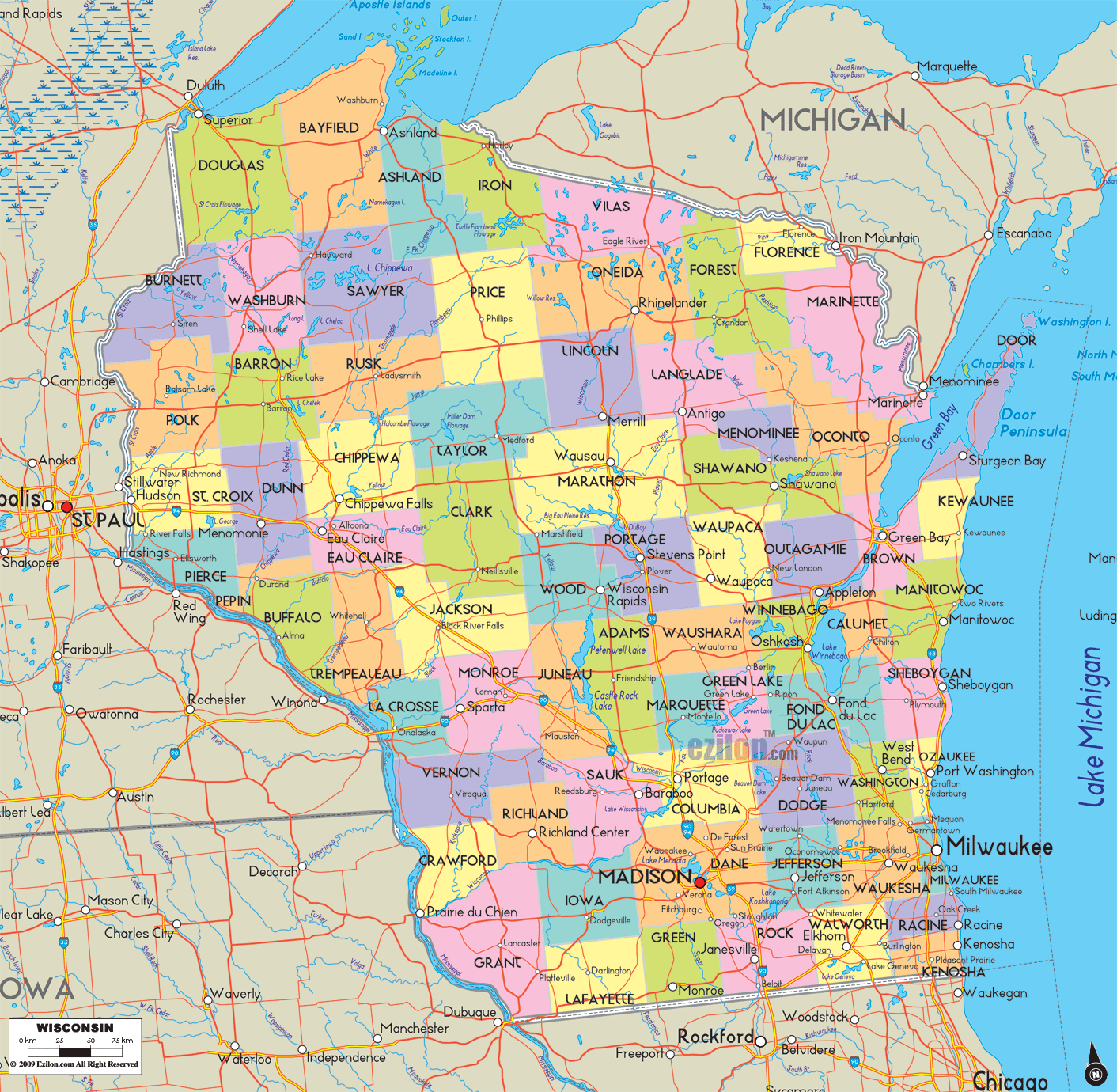
Wisconsin Lakes and Rivers Map
Geography
Wisconsin is bordered by the Montreal River; Lake Superior and Michigan to the north; by Lake Michigan to the east; by Illinois to the south; and by Iowa to the southwest and Minnesota to the northwest. A border dispute with Michigan was settled by two cases, both Wisconsin v. Michigan, in 1934 and 1935. The state’s boundaries include the Mississippi River and St. Croix River in the west, and the Menominee River in the northeast.
With its location between the Great Lakes and the Mississippi River, Wisconsin is home to a wide variety of geographical features. The state is divided into five distinct regions. In the north, the Lake Superior Lowland occupies a belt of land along Lake Superior. Just to the south, the Northern Highland has massive mixed hardwood and coniferous forests including the 1,500,000 acres (6,100 km) Chequamegon-Nicolet National Forest, as well as thousands of glacial lakes, and the state’s highest point, Timms Hill. In the middle of the state, the Central Plain has some unique sandstone formations like the Dells of the Wisconsin River in addition to rich farmland. The Eastern Ridges and Lowlands region in the southeast is home to many of Wisconsin’s largest cities. The ridges include the Niagara Escarpment that stretches from New York, the Black River Escarpment and the Magnesian Escarpment.
In the southwest, the Western Upland is a rugged landscape with a mix of forest and farmland, including many bluffs on the Mississippi River. This region is part of the Driftless Area, which also includes portions of Iowa, Illinois, and Minnesota. This area was not covered by glaciers during the most recent ice age, the Wisconsin Glaciation. Overall, 46% of Wisconsin’s land area is covered by forest. Langlade County has a soil rarely found outside of the county called Antigo silt loam.
Wisconsin has sister-state relationships with Germany’s Hesse, Japan’s Chiba Prefecture, Mexico’s Jalisco, China’s Heilongjiang, and Nicaragua.
Climate
Most of Wisconsin is classified as warm-summer humid continental climate (Köppen Dfb), while southern and southwestern portions are classified as hot-summer humid continental climate (Köppen Dfa). The highest temperature ever recorded in the state was in the Wisconsin Dells, on July 13, 1936, where it reached 114 °F (46 °C). The lowest temperature ever recorded in Wisconsin was in the village of Couderay, where it reached −55 °F (−48 °C) on both February 2 and 4, 1996. Wisconsin also receives a large amount of regular snowfall averaging around 40 inches (100 cm) in the southern portions with up to 160 inches (410 cm) annually in the Lake Superior snowbelt each year.
Wisconsin Physical Map
Wisconsin Topographic Map
Wisconsin Satellite Map
Others printable maps
Wisconsin Outline Map
Blank Wisconsin County Map
See also
Map of Wisconsin State and its subdivision:- Adams
- Ashland
- Barron
- Bayfield
- Brown
- Buffalo
- Burnett
- Calumet
- Chippewa
- Clark
- Columbia
- Crawford
- Dane
- Dodge
- Door
- Douglas
- Dunn
- Eau Claire
- Florence
- Fond du Lac
- Forest
- Grant
- Green
- Green Lake
- Iowa
- Iron
- Jackson
- Jefferson
- Juneau
- Kenosha
- Kewaunee
- La Crosse
- Lafayette
- Lake Michigan
- Lake Superior
- Langlade
- Lincoln
- Manitowoc
- Marathon
- Marinette
- Marquette
- Menominee
- Milwaukee
- Monroe
- Oconto
- Oneida
- Outagamie
- Ozaukee
- Pepin
- Pierce
- Polk
- Portage
- Price
- Racine
- Richland
- Rock
- Rusk
- Saint Croix
- Sauk
- Sawyer
- Shawano
- Sheboygan
- Taylor
- Trempealeau
- Vernon
- Vilas
- Walworth
- Washburn
- Washington
- Waukesha
- Waupaca
- Waushara
- Winnebago
- Wood
- Alabama
- Alaska
- Arizona
- Arkansas
- California
- Colorado
- Connecticut
- Delaware
- District of Columbia
- Florida
- Georgia
- Hawaii
- Idaho
- Illinois
- Indiana
- Iowa
- Kansas
- Kentucky
- Louisiana
- Maine
- Maryland
- Massachusetts
- Michigan
- Minnesota
- Mississippi
- Missouri
- Montana
- Nebraska
- Nevada
- New Hampshire
- New Jersey
- New Mexico
- New York
- North Carolina
- North Dakota
- Ohio
- Oklahoma
- Oregon
- Pennsylvania
- Rhode Island
- South Carolina
- South Dakota
- Tennessee
- Texas
- Utah
- Vermont
- Virginia
- Washington
- West Virginia
- Wisconsin
- Wyoming
